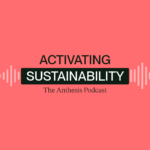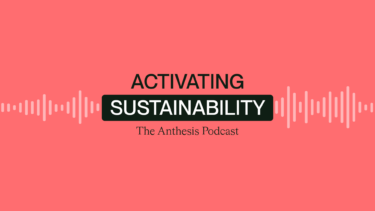In this JUST IN episode of our Activating Sustainability series, our host Chris Peterson is joined by Victoria Evans, Director, and Kim van Boden, Principal Consultant, to discuss the recent California climate bills that Governor Newsom signed into law on 7th October.

Inside this podcast
Join them as they explore:
- What’s inside the bills.
- Why people should care about the bills.
- How companies can prepare for the requirements in the bills.
Listen on your favourite podcast app
Chris: Hello, welcome to activating sustainability in the Anthesis podcast. I’m your host, Chris Peterson, and today we’re doing a breaking news podcast on the newly signed California climate related bills. To help me and hopefully you understand what they are and what they mean. We’re doing a quick recording with two members of our Anthesis climate practice, Victoria Evans, who’s director and service line lead, and Kim Van Boden, principal consultant.
Thank you both so much for joining. We really appreciate it.
Victoria: Thanks for having us today.
Kim: Thank you.
Chris: Absolutely. Maybe Victoria, you can kind of kick us off by giving us a sense for what are these bills.
Victoria: So we have, we actually have 2 bills. I’ll speak about the 1st one having to do with greenhouse gas mandatory reporting, California now has a new mandatory reporting requirements for carbon. The new law is known as SB 253. The Climate Corporate Data Accountability Act. It was signed by Democratic Governor Newsom recently on Saturday, October 7th. In his signing letter, the governor did formally indicate that the law may be amended in 2024 to address a few issues.
But today we’ll just take a quick look at what’s in the law as it stands today. This new law requires corporations to provide public disclosure of greenhouse gas emissions by annually reporting their corporate wide inventories. However, this only applies to companies established in the U. S. and to large public and private firms, and only to those doing business in California.
So large, large means companies over a billion in annual revenues. And then in terms of doing business in California, that definition will be based on the specifics that the California Franchise Tax Board has um, put online if you need to take a look at that. So there’s several different criteria that are used to um, frame out that applicability.
So, The regulations will be written by the California Air Resources Board and they’re due to be final by January. Of 2025. So companies are expected to start reporting annually for their fiscal year and to provide third party assurance for it. The first inventory year for scopes one and two greenhouse gas will cover activities during 2025.
And the first Scope 3 reporting starts later, covering activities for 2026. So that’s about it. This, uh, state law does not affect companies established outside of the U. S. because California, after all, is a state and not the federal government. So, that’s the way that’ll work. This is unlike some of the rules that are in place in the EU and the UK.
Kim: So, the California SB 261 is the other bill, and that covers climate related financial risk disclosures. So, similarly, similar coverage in covering companies that do business in California with a lower annual revenue threshold. Um, in this case, it is of at least 500 million dollars annually. Um, those companies who the law pertains to will be required to submit a report to the California Air Resources Board every other year that discloses their climate related financial risk.
And so it’s estimated that the law will affect over 10, 000 companies, um, and the law also specifies that disclosure should be in alignment with TCFD or the Task Force on Climate Related Financial Disclosures. Or a successor thereof. So that’s an interesting element in that. Um, we’ve been hearing recently with the release of the IFRS’s, um, S2 standards that they are kind of subsuming, T C F D.
Um, so I think we can. Assume that I F R S S2 will kind of take hold and be the one that companies should be aligning with. Um, it’s interesting that the S2 standard is a little bit more prescriptive than T CFD in some areas, so it requires some more detailed information on how companies plan to respond to identify climate risks and opportunities.
Um, it does require scenario analysis, although kind of does acknowledge that companies should only. Do a scenario analysis within appropriate resources and costs to them and doesn’t specify any certain scenarios to use, but does ask companies to report on its capacity to adjust business model and strategy based on the resilience assessment.
So just some interesting, um, differences there. And then these, the first reports will be due by companies by January 1st, 2026 under, um, SB 261. So a couple of years to kind of get everything in order and start preparing for that one.
Chris: Great. No, really appreciate it because I heard lots about them. So really helpful to have that kind of context for what’s actually in the bills.
Um, I feel like some of this is self evident, but we’re really curious as experts in this space, kind of, why do you think people should really care about these?
Victoria: These are mandatory requirements for compliance, so… Um, there’s actually penalties associated with not filing, so that’s sort of maybe the one reason why, um, there’s lots of other reasons why.
I mean, there’s drivers for the state of California. They’re interested in, in looking at the companies that actually do business in California to assess them versus the rest of the emissions that the state is, uh, quite knowledgeable about for the large facilities and fuel providers that they already regulate here under the cap and trade program.
Kim: Yeah, and then for, um, SB 261. So, of course, the objective with, with this law, similarly with others, other frameworks, um, and laws across the globe, um, the objective is to provide greater transparency to stakeholders, like policy makers, um, uh, stakeholders. Customers, investors and shareholders on a company’s exposure to climate risks.
Um, and what they’re doing to prepare for or, or mitigate those risks, um, to then inform capital allocation decisions. So these disclosures on climate risk are going to be, um, You know, scrutinized more closely. Companies are going to have to really take climate action seriously. Um, with this being a requirement for companies to report on, um, also very interesting that, um, this is kind of the first mandatory action around climate risk in the U. S. Um, we have been hearing and and following, of course, the SEC’s proposed regulation on climate risk and still awaiting a final decision there, but it will be. It’s interesting to see how this regulation kind of influences the SEC, um, if they mirror each other or if there are significant differences. So, um, these, these climate risk disclosures are becoming more and more mandatory.
Um, so it’s only kind of a matter of time and, and great to see the US kind of taking some, some action here too.
Chris: Great. Yeah. And, you know, as we think about kind of that timeline that both of you explained, I mean, that is coming up just around the corner. So curious what you all would recommend for listeners in terms of what they should be doing today or tomorrow to get ready for this.
Are there specific steps, actions, priorities?
Victoria: So, just briefly, if a company has any doubts about their applicability to each, either of these laws, there, I would suggest, um, in some cases, I can understand where it might be a bit ambiguous that, uh, folks formally assess their company’s applicability of the law to their company here for reporting.
It’s one thing to have a revenue threshold, but it’s another to have. There’re about three criteria to use to figure out applicability for doing business in California. It’s not as simple as it might sound. And then the second thing, right, is to get prepared. And in this case, it doesn’t matter. It’s for either one of these.
You know, get prepared for your annual inventory and assurance. If you haven’t already done that, many folks have, especially at the level of the firms that are being affected by the requirements. And then if, um, not already doing this, I would track the regulatory development for each of these bills going forward, especially for the greenhouse gas, because the reporting requirements that the Air Resources Board puts out will be necessarily specific if they follow their historic pathway in this space.
So there’ll be some very possible, uh, specific differences in this type of reporting than in, uh, reporting done elsewhere. So it’s kind of 1 of those. Stay tuned moments.
Chris: And maybe just picking up on 1 piece, Victoria, you mentioned kind of getting prepared and I’m curious kind of what you see as a reasonable timeline for that.
Victoria: Well, our experience working with folks, we do about 150 inventories a year for companies of all sizes. So it can take anywhere from three months to a year and a half to get folks all the way through a scope one and two inventory plus an initial read on their scope three inventory. So I’m hopeful that folks and firms at the level that are affected here, you know, will have already done quite a bit of this work.
and um, they may need to just, um, perhaps tighten up on their, um, inventory data collection and accuracy, those sorts of things, and then look at their Scope 3 in a little more detail, or let’s say if they haven’t done it at all, now would be a good time to start.
Chris: Right. I mean, fascinating to see this shift from kind of voluntary disclosure to mandatory disclosure, like you were saying, Kim.
Are there other pieces that, as you think about, kind of advice, guidance, et cetera, that come to mind for you?
Kim: Yeah, definitely. Um, I think for the climate related financial risk disclosure, um, with these reports being due starting in January 1st, 2026, it may seem like a lot of runway, but there’s, there’s a lot of work that needs to be done to kind of, kind of put together one of these reports that are TCFD or IFRS S2 aligned.
We typically recommend it. That company start with a climate risk assessment to really get an understanding of what their climate risk universe looks like. Um, so looking at both physical and transition risks and getting a sense of where the company’s risk exposure might be, um, within those climate risks.
Scenario analysis is another one kind of looking at across different climate scenarios, a high, medium and low warming. Scenario, um, how those physical and transition risk exposures change over time for the company. Um, and then starting to kind of put some, some financial data to that, or getting a sense of what financial data may be needed in the future to advance that analysis, since that can be tricky.
Those are some couple key steps to getting that alignment with those reporting frameworks. And then another piece I’ll, I’ll add is that element of internal education and just kind of getting. Organized internally, starting to use climate related vocabulary across functions within the business to start embedding climate considerations.
Yeah, across the organization.
Chris: Well, that’s great. There’s so much more for us to unpack within this, but really appreciate you both kind of jumping in, giving us kind of the quick overview of what it is, why we should care and kind of how we can respond to it. Uh, so thank you both very much. Really appreciate it.
Kim: Thank you.
Victoria: Welcome.
Chris: Yeah. And thank you all so much for listening. As always, there’s lots of really valuable resources up on the anthesis group. com website. And all of us are reachable via email at first dot last name at anthesis group dot com. So, thank you again, take care, and we’ll talk to you soon.





